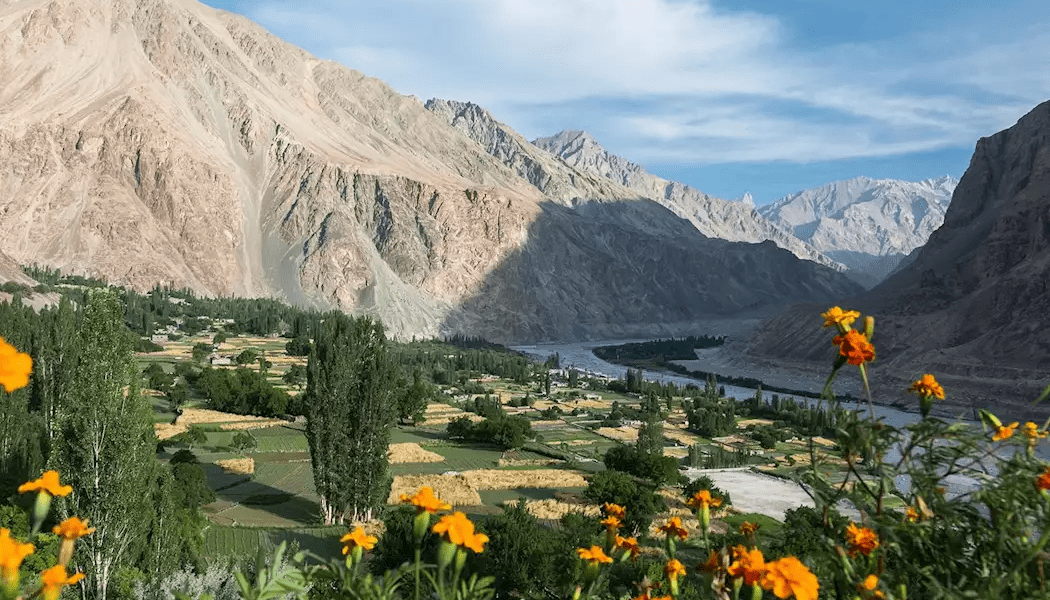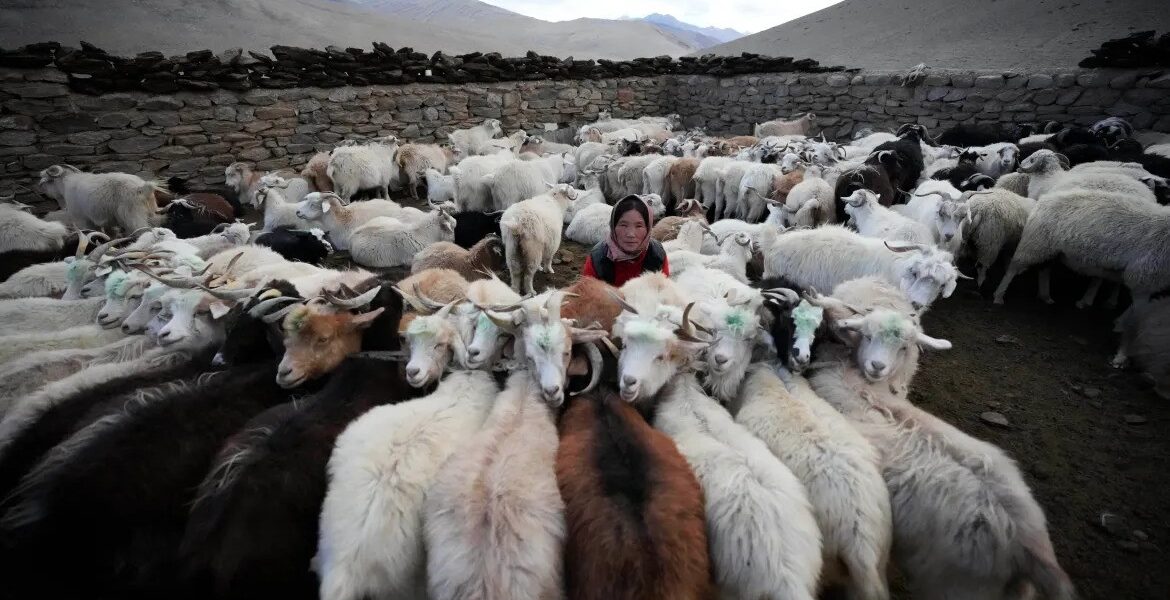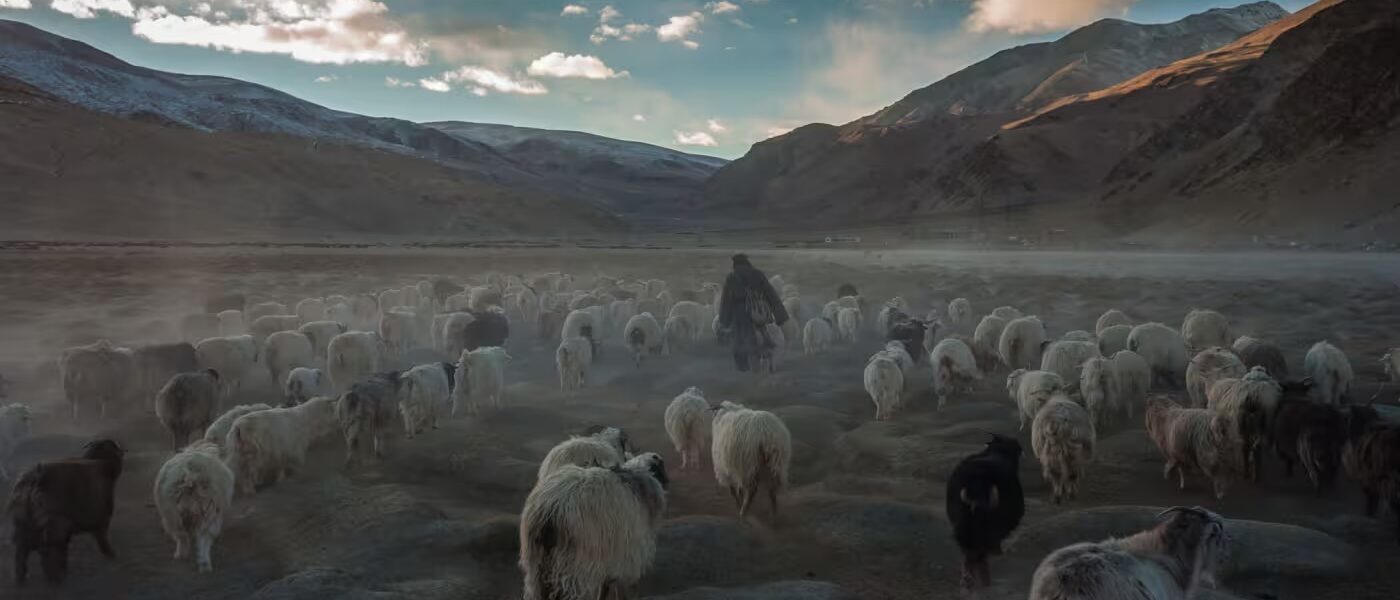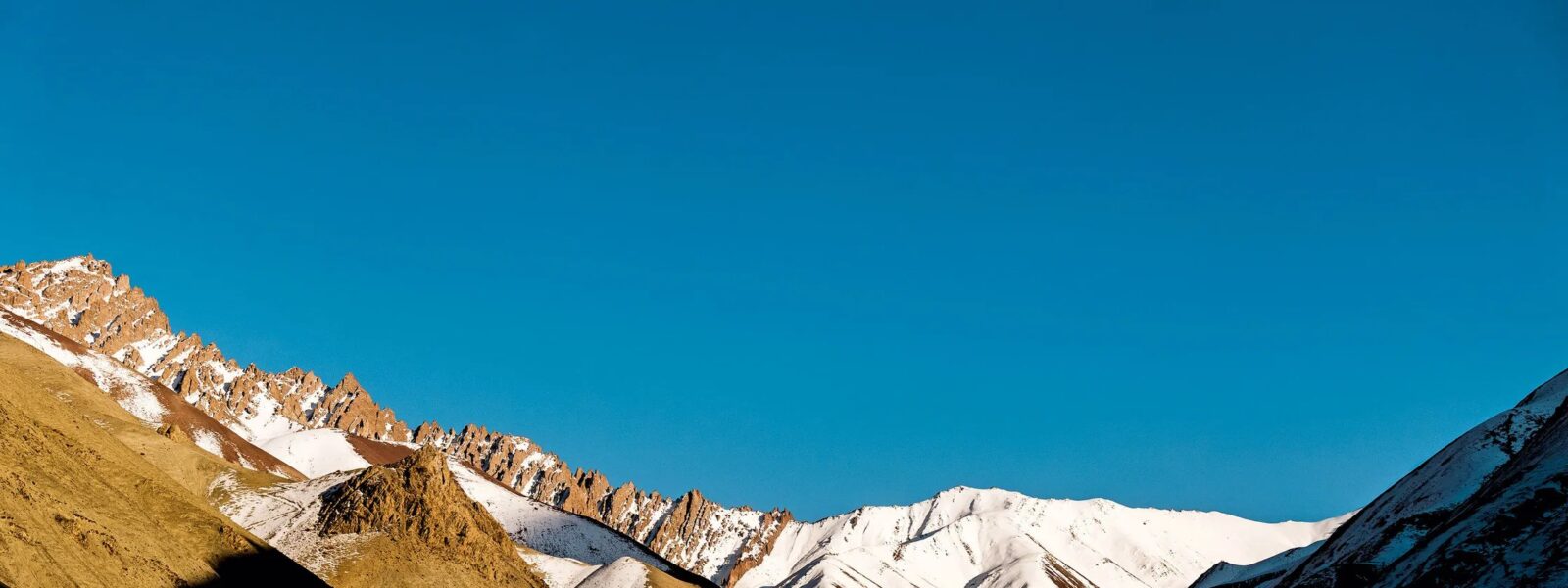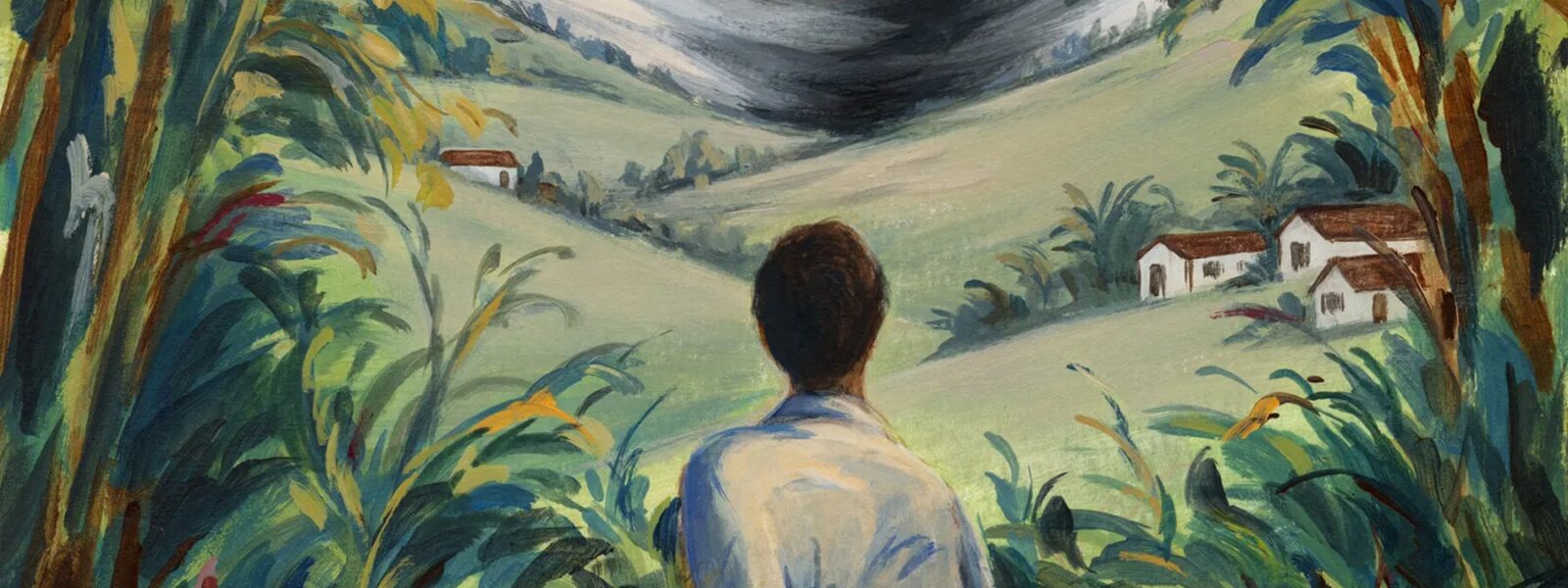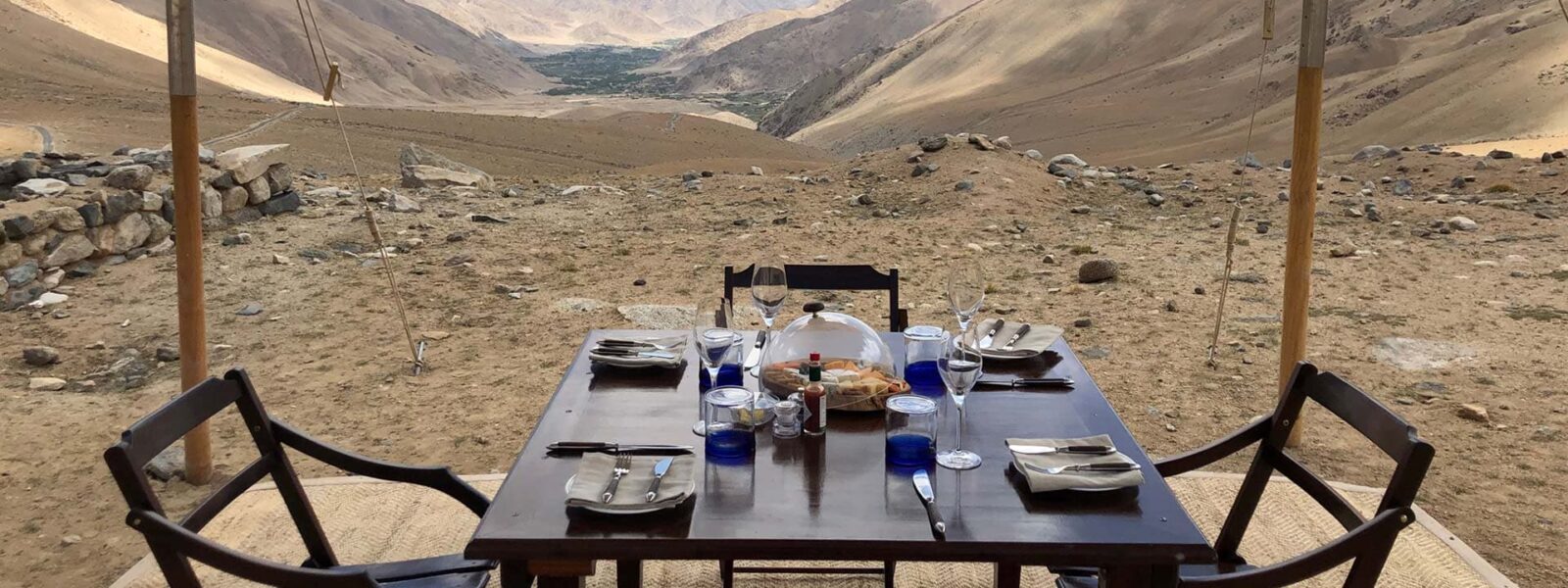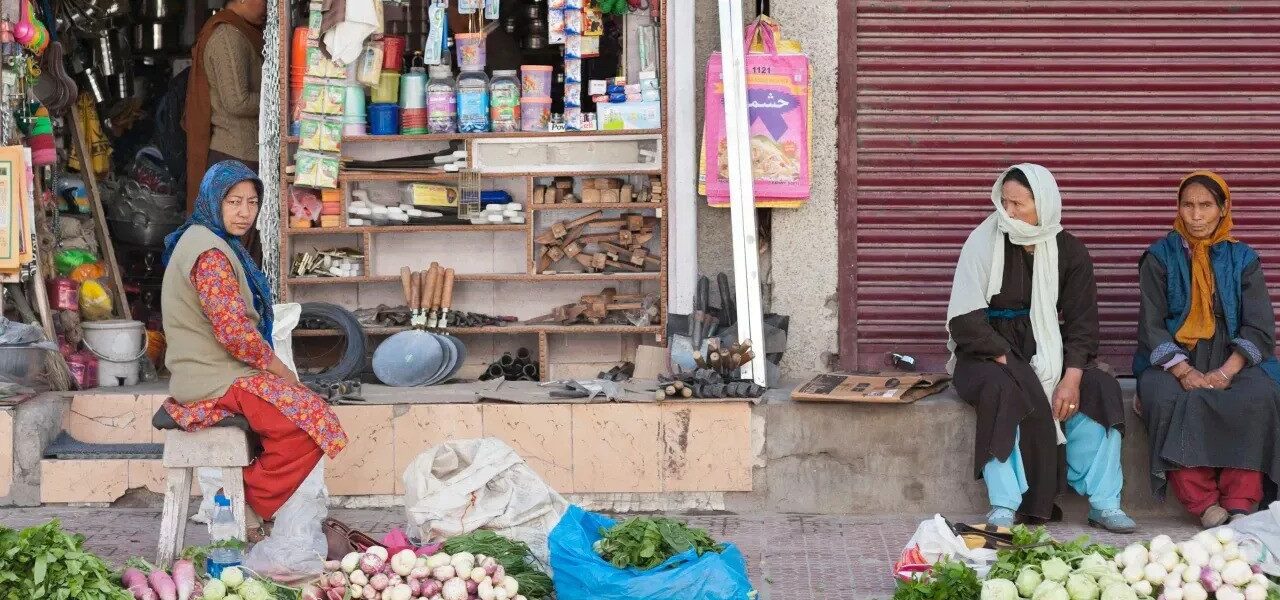What Makes Nubra Valley Special?
Nestled between the Karakoram and Ladakh ranges in northern India, Nubra Valley feels like a land lost in time—where glacial rivers weave through desert sand dunes and ancient Buddhist monasteries perch on rocky cliffs. It’s a place that surprises even the most seasoned travelers. Often dubbed the “valley of flowers of Ladakh,” Nubra is not just a pretty name. The region blooms with wild lavender and rose-colored willows during the summer months, while its dramatic terrain reminds visitors they are standing at the edge of the Tibetan Plateau.
Traveling to Nubra Valley is like unlocking a secret chamber in the Himalayas. At once rugged and tender, its beauty lies in its contrasts: wide, sweeping valleys that shift from icy mountain passes to swirls of golden sand; meditative stillness broken by the laughter of children herding goats; and the overwhelming silence punctuated by the low hum of prayer wheels turning in a monastery courtyard.
The valley is divided by two important rivers — the Nubra and the Shyok — whose waters snake through this high-altitude cold desert, carving oases of green amidst a sea of brown and white. The Shyok River, meaning “river of death,” might sound ominous, but its shimmering banks are among the most peaceful stretches you’ll find in Ladakh. These rivers nourish villages like Diskit, Hunder, Turtuk, and Panamik, each with its own character, charm, and untold stories.
But what truly makes Nubra special isn’t just its landscape. It’s the people who live here — a blend of Buddhist and Balti Muslim communities, each preserving a unique cultural identity. Visitors are often welcomed with butter tea, dried apricots, and tales of life under the open sky. The valley’s remote location — reachable only by crossing the formidable Khardung La pass — means it has remained relatively untouched by mass tourism. And that’s exactly what makes it magical.
For those looking to go beyond the usual itineraries, Nubra offers a rare sense of peace and perspective. It’s not just about checking off attractions; it’s about experiencing the vastness of silence, the richness of high-altitude life, and the resilience of communities who thrive where others would barely survive.
Whether you’re exploring the labyrinthine lanes of a remote village, watching double-humped camels trot across dunes at sunset, or simply sipping tea while clouds drift over the snow-capped peaks, Nubra Valley has a way of slowing you down — and showing you something timeless.
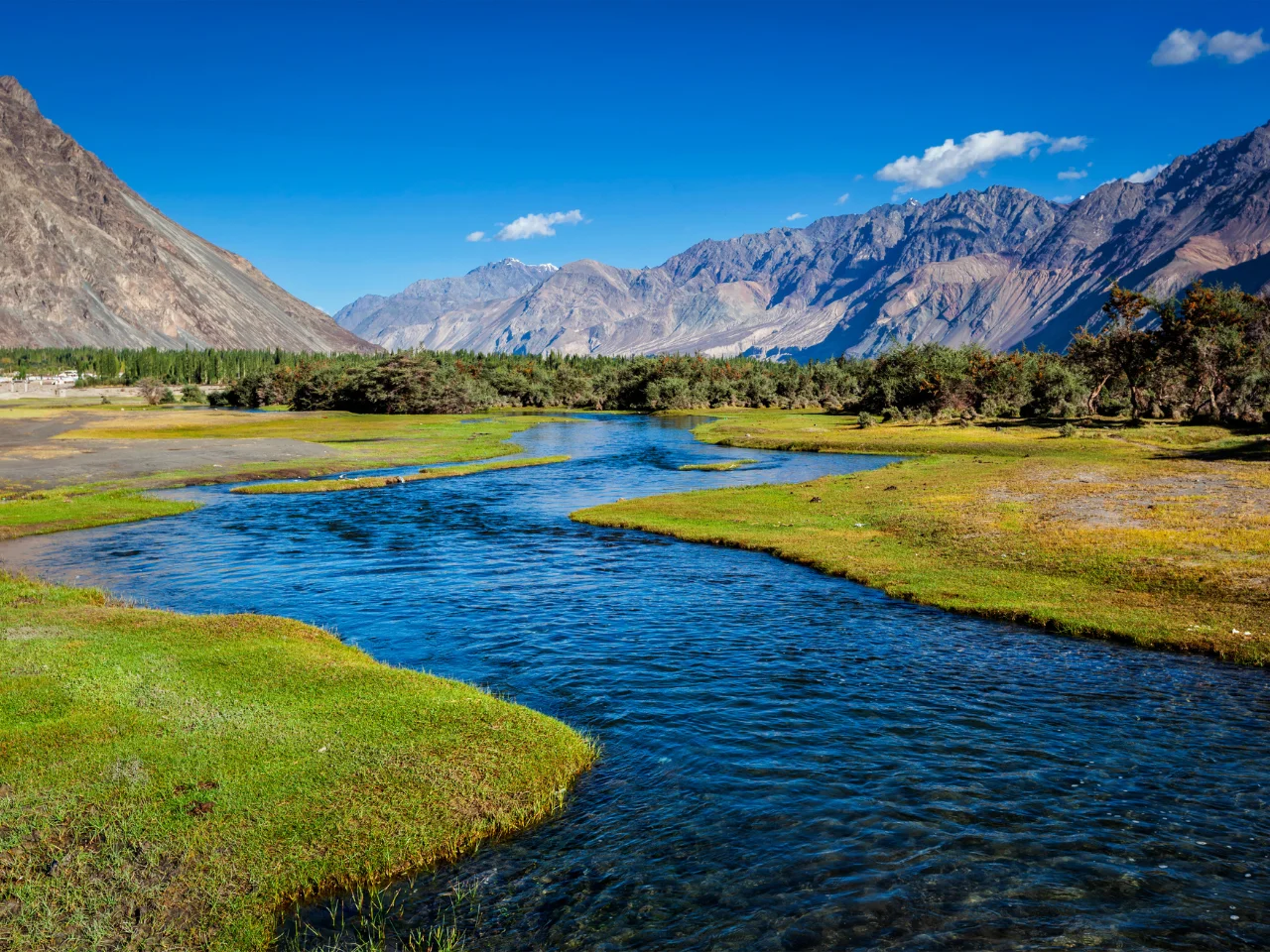
How to Reach Nubra Valley from Leh
Getting to Nubra Valley is a journey that defines the essence of adventure. It’s not just a matter of covering kilometers—it’s a transition into an entirely different world. The valley lies about 120 kilometers north of Leh, and the only land route connecting the two cuts through one of the highest motorable roads in the world: Khardung La Pass. Towering at an altitude of 5,359 meters (17,582 feet), this pass is more than a milestone—it’s a rite of passage for every traveler stepping into Nubra’s mystical realm.
The road from Leh to Nubra begins with a steady climb out of the city, winding past military encampments and prayer-flag-strewn chortens, before ascending sharply into the thin air of Khardung La. Weather permitting, the summit offers staggering views over snowbound peaks and valleys that stretch to the edge of imagination. Breathing might be shallow up here, but the beauty is breathtaking.
After crossing the pass, the descent into the Nubra Valley is like entering another dimension. The stark, barren mountains give way to fertile plains and sparkling riverbeds. The change in landscape is dramatic: snow fades into sand, jagged ridgelines into rounded dunes, and stillness into movement as you pass tiny villages filled with fluttering prayer flags and barley fields.
There are multiple options to make this trip. Hiring a private taxi is the most comfortable and flexible choice, especially for those wanting to stop for photos or acclimatize slowly. Shared cabs are available at Leh’s taxi stand and offer a more affordable option for solo travelers. For the more adventurous, renting a motorbike is a thrilling way to take in the open road—but be warned, the high altitude and sudden weather changes require caution and experience.
It’s worth noting that all travelers, including Indian nationals, must obtain an Inner Line Permit (ILP) to access Nubra Valley. This can be done easily online or at the Leh DC office. Remember to carry multiple photocopies of your permit, as you’ll need to submit them at army checkpoints along the way.
The best time to travel from Leh to Nubra is between May and September when the roads are open and relatively safe. In winter, heavy snowfall often closes Khardung La, cutting off access to the valley. If you’re visiting in early spring or late autumn, it’s wise to check road conditions and weather forecasts in advance.
This journey isn’t merely a means to an end—it’s part of the magic. The route to Nubra Valley is an odyssey of changing altitudes, cultures, and colors. It prepares you, slowly and surely, for the tranquility and wonder that awaits on the other side of the mountains.
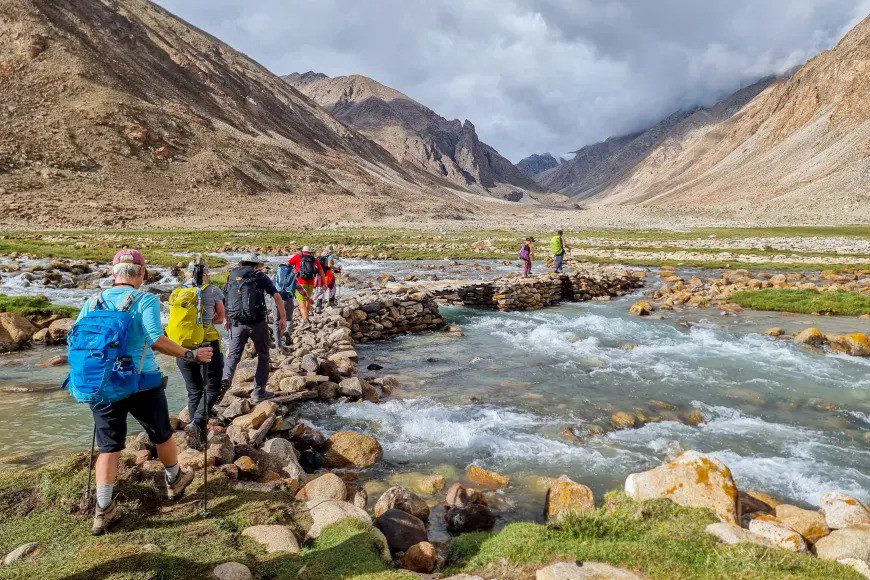
Hunder’s Magical Sand Dunes and Bactrian Camels
Just when you think Ladakh can’t surprise you any more, the village of Hunder proves otherwise. Nestled between the icy arms of the Karakoram Mountains and the winding Shyok River, Hunder is home to a surreal stretch of golden sand dunes — an improbable desert at 10,000 feet. This is Nubra Valley’s most iconic landscape, where nature rewrites the rules and double-humped camels stroll through the high-altitude silence like something from a dream.
Once part of the ancient Silk Route, Hunder served as a bustling transit point between Central Asia and the Indian subcontinent. Today, its legacy lives on in the form of Bactrian camels — hardy, woolly, two-humped creatures that once carried goods across inhospitable terrain. These gentle giants are now the stars of Hunder’s sand dunes, offering visitors an unforgettable ride through a Himalayan desert that defies all expectations.
The dunes themselves are soft and shimmering, their contours shifting subtly with each passing breeze. Whether you’re exploring them on foot or by camelback, the atmosphere is meditative. The sun casts dramatic shadows across the landscape, making it a favorite spot for photographers during the golden hours of dawn and dusk. You’ll often see families picnicking, kids chasing the wind, and travelers standing quietly, as if trying to grasp how such a place can exist.
Camel rides are typically short and guided by local herders who have cared for these animals for generations. While some visitors might view it as a novelty, the camel ride is more than just a photo opportunity — it’s a glimpse into a way of life that connected continents long before modern borders were drawn. The camels, bred in Nubra for decades, are well-adapted to the climate and terrain, and many herders treat them like family.
Beyond the dunes, Hunder is also a peaceful village with apricot orchards, traditional Ladakhi homes, and clear views of the snow-capped peaks in the distance. It’s a wonderful place to base yourself for a night or two, especially if you’re seeking tranquility away from the more crowded stretches of Leh.
For travelers interested in sustainable tourism, local eco-resorts and family-run guesthouses are available, ensuring your stay benefits the community. Whether you’re chasing sunrise over the dunes or simply listening to the rustle of wind against sand, Hunder is a reminder that magic often happens in the most unexpected places.
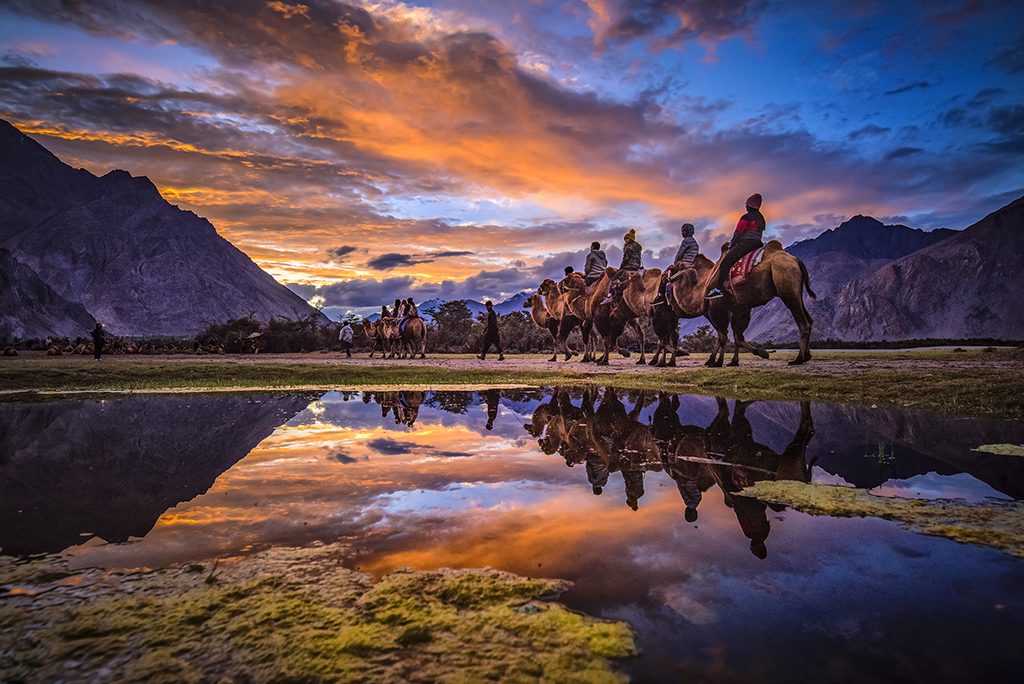
Sacred Sites and Monasteries in Nubra Valley
Beyond its breathtaking landscapes and dramatic geography, Nubra Valley is also a spiritual sanctuary. Dotted across its rugged terrain are centuries-old monasteries that offer not just religious significance but also stunning views, peaceful moments, and a deeper understanding of Ladakh’s Tibetan Buddhist heritage. These gompas—monastic complexes built with stone and prayer—invite visitors to slow down and connect with something timeless.
The most famous of them all is the Diskit Monastery, perched high on a rocky hill overlooking the valley floor. Founded in the 14th century by Changzem Tserab Zangpo, a disciple of Tsongkhapa (founder of the Gelugpa school), Diskit is the oldest and largest monastery in Nubra. The approach itself is spectacular, winding through stone paths lined with mani walls and fluttering prayer flags. At the top, a giant Maitreya Buddha statue, standing 32 meters tall, gazes serenely across the valley. It’s not just a monument — it’s a guardian of peace and a symbol of hope in a landscape carved by time.
Stepping inside the monastery feels like entering another era. Butter lamps flicker in the dim light, monks chant in unison during their daily prayers, and the air is heavy with the scent of incense and ancient wood. Visitors can explore the various prayer halls adorned with murals, thangkas (Buddhist scroll paintings), and sacred texts. Time seems to slow here, and even the casual traveler can’t help but feel a sense of reverence.
Nearby lies the village of Sumur, home to the serene Samstanling Monastery. Painted in earthy reds and golden yellows, this monastery is nestled among willow trees and barley fields. Unlike the grandeur of Diskit, Samstanling offers a more intimate spiritual experience. It’s often less crowded and provides an excellent chance to witness the quiet rhythms of monastic life — young novices reciting texts, elders sweeping courtyards, and the occasional conversation carried on the wind.
These monasteries are not just architectural wonders. They are living, breathing institutions — places of learning, reflection, and community. Visiting them is not about sightseeing alone. It’s about standing still long enough to hear the valley whisper its stories through prayer wheels and temple bells.
As with all sacred places, visitors are encouraged to show respect: dress modestly, speak softly, and ask before photographing monks or sacred spaces. Many monasteries accept donations, which go toward supporting monastic education and preserving heritage — a meaningful way for travelers to give back.
Whether you’re devout or simply curious, the sacred sites of Nubra Valley invite you to take a spiritual pause. In a land shaped by wind and ice, it is these quiet sanctuaries that remind us of the warmth of faith and the endurance of tradition.

Turtuk — The Last Village Before Pakistan
There’s something extraordinary about reaching the edge of a country, and in Ladakh, that edge is called Turtuk. Tucked away in the far northwest of Nubra Valley, just a stone’s throw from the Line of Control, Turtuk is one of India’s northernmost villages and a destination unlike any other. Reopened to travelers only in 2010, this remote hamlet in the Shyok River valley offers not just a geographic extreme, but a cultural revelation.
Turtuk is part of the Baltistan region, and its people — known as Balti — speak a Tibetan dialect, follow Islam, and live in traditional stone-and-wood homes that seem suspended in time. Walking through the village is like entering a living museum: narrow lanes wind between ancient houses, apricot trees bloom in every direction, and children peek from carved wooden balconies with curious smiles. The air smells of ripening fruit and wood smoke, and time ticks slower here.
Once administered by Pakistan, Turtuk became part of India after the 1971 war. Despite its complicated history, the village today radiates warmth and hospitality. Many families now host travelers in their homes, serving traditional Balti meals like plaphoo (buckwheat pancakes) and zoq (spiced apricot soup). A walk through Turtuk isn’t complete without visiting its small museum, which displays relics from the pre-1971 era — including old currency, tools, and maps that reflect its complex identity.
The village is spread across several levels, connected by stone pathways and wooden bridges over glacial streams. One of the best ways to experience it is simply by wandering — from the centuries-old mosques to the lush apricot orchards and the quiet hilltop viewpoints that overlook the Shyok River’s snaking path. The surroundings are so green and fertile that it’s easy to forget you’re in Ladakh’s cold desert.
Turtuk also offers immersive cultural encounters. Guests can join apricot harvests in late summer, attend local music performances, or listen to the elders’ stories of a divided land and a shared past. Unlike the Buddhist heartlands of Ladakh, Turtuk’s Islamic heritage brings a different flavor to the region — not a contrast, but a rich layer in Nubra’s cultural mosaic.
For travelers seeking authenticity, Turtuk is a rare gem. It’s a place where you won’t find flashy cafés or tourist traps. Instead, you’ll find raw beauty, resilience, and relationships formed over shared cups of salty tea. In a world that’s increasingly connected yet culturally blurred, Turtuk offers something real: a chance to slow down and understand what it means to live at the edge — and to do so with grace.
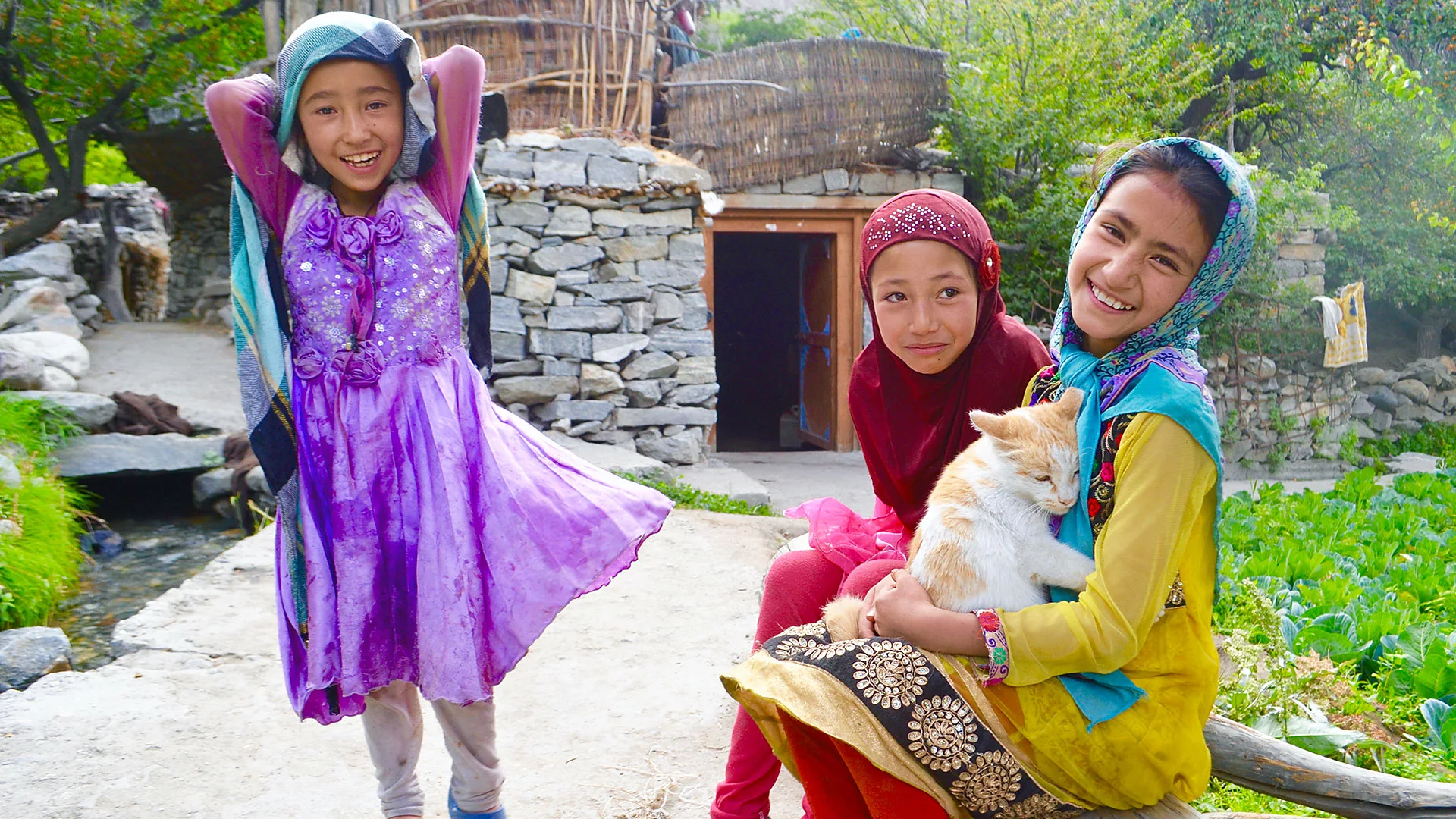
Panamik Hot Springs and Remote Villages
At the farthest accessible reaches of Nubra Valley lies a village that bubbles with warmth — literally. Panamik, known for its natural hot springs, offers a surprising contrast to the cool, arid climate of Ladakh. Surrounded by snow-dusted peaks and fed by underground geothermal activity, these healing waters have drawn travelers, pilgrims, and locals for generations. If you’ve just crossed Khardung La or explored the windy dunes of Hunder, a dip in Panamik’s steaming pools feels like a gift from the earth itself.
The sulphur-rich hot springs of Panamik are believed to have medicinal properties that soothe joint pain and skin conditions. A basic bathhouse allows visitors to enjoy the warm waters in a modest, no-frills setting — not luxurious, but entirely authentic. The setting itself is spectacular: on clear days, the village opens up to sweeping views of the Sasser and Karakoram ranges. The steam rising from the springs against the backdrop of jagged ridgelines creates a surreal scene — one you won’t forget easily.
Panamik is also the last village on the road north, and beyond it lies the restricted area leading toward the Siachen Glacier. But it’s not just a place to soak and stare. The village offers a glimpse into Ladakhi life at its most remote. Whitewashed chortens, stupas with fluttering prayer flags, and small homesteads surrounded by barley fields make up the village landscape. Life here moves at a slower pace, and visitors often find themselves pausing more — for conversations, for mountain views, for silence.
Nearby, the village of Ensa hides a secret: an ancient, little-visited monastery perched high on a rocky ridge. The trail to Ensa Monastery is a gentle hike from Panamik and rewards with solitude, faded murals, and whispering winds. For those who venture off the main road, this quiet detour offers spiritual reflection without the crowds.
Other villages in the Nubra Valley’s northern arm, such as Taksha and Charasa, remain delightfully untouched. Here, you’ll find children playing in glacier-fed streams, women carrying woven baskets of greens, and elders watching the world from shaded porches. While tourism is growing, the rhythm of daily life still follows the seasons, the harvest, and the rising and setting of the sun.
Staying in these remote villages means waking up to birdsong, drinking salty butter tea, and watching clouds gather above fields that seem carved into the earth by hand. It’s not luxury that draws people to Panamik and its neighbors — it’s the rare chance to witness Ladakh’s still-beating heart, far from the highways and honking horns.
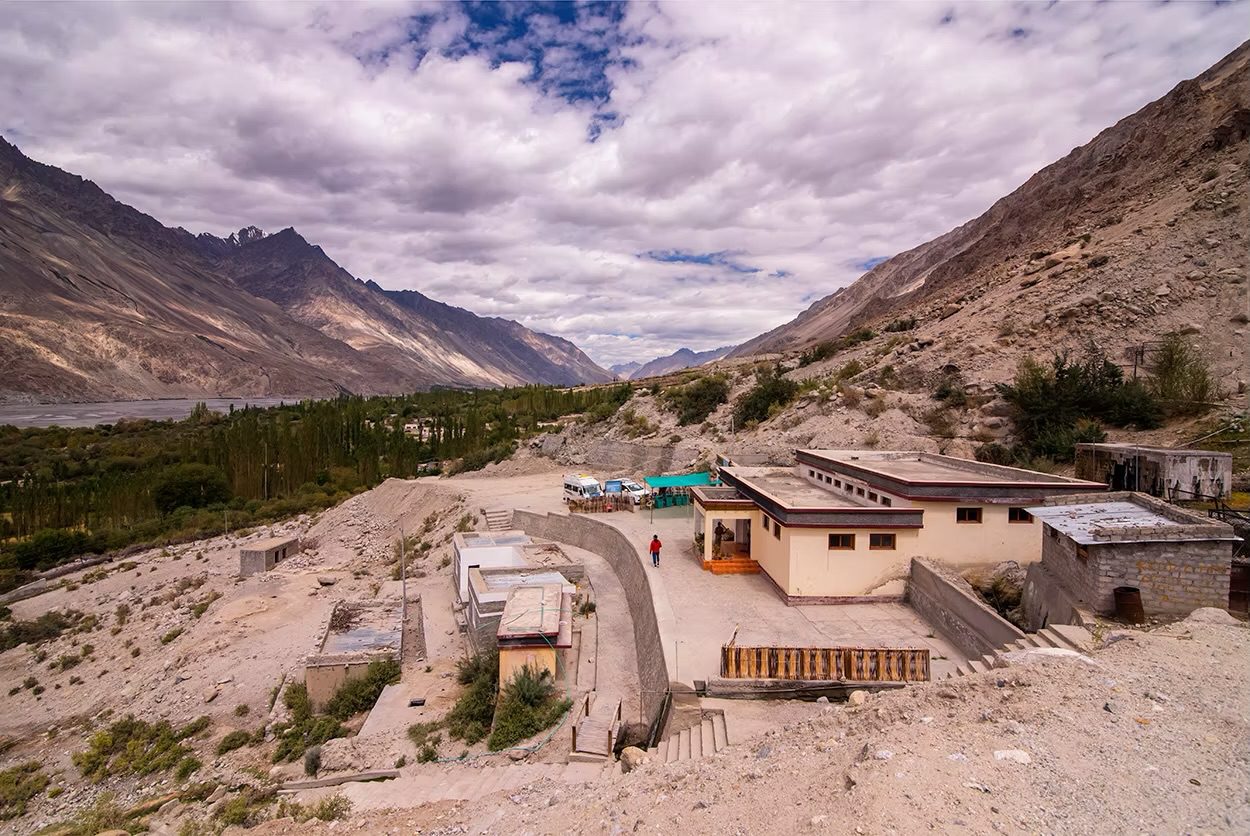
Where to Stay in Nubra Valley — Eco-Resorts and Homestays
In a region where the air is pure, the landscapes untouched, and the pace of life beautifully slow, where you stay can shape your entire experience. Nubra Valley is no longer just a destination for the rugged backpacker. Today, a range of eco-conscious accommodations allows travelers to enjoy comfort without compromising the fragile environment that makes this place so unique. From elegant eco-resorts nestled in apricot orchards to humble, welcoming village homestays, Nubra has something for every soul seeking a meaningful stay.
One of the standout stays in the valley is The Kyagar, an eco-resort located in the peaceful village of Sumur. This thoughtfully designed property blends Ladakhi architecture with modern comfort and sustainability. Constructed using local materials, The Kyagar features rooms that stay cool in the summer and warm in the early spring and autumn months without needing artificial climate control. Guests wake up to views of barley fields, dine on fresh, locally grown food, and relax in serene courtyards that invite introspection. The staff are locals, the energy usage is minimal, and the values are rooted in respect — for both land and culture.
Further up the valley, near Turtuk and Hunder, properties like Lchang Nang Retreat and Stone Hedge have carved out a niche among discerning travelers who seek immersive experiences. Lchang Nang, known as “The House of Trees,” is set among groves of poplars and apricots, offering stone cottages, open skies, and the kind of silence that’s hard to find elsewhere. Meals are served family-style, and each guest is gently encouraged to unplug, slow down, and simply be.
For those who want to experience true Ladakhi hospitality, staying in a homestay is both rewarding and responsible. Villages like Turtuk, Sumur, and Panamik offer homestays run by local families who open their doors — and their hearts — to travelers. You’ll sleep in traditional rooms adorned with handwoven rugs, eat home-cooked meals that change with the seasons, and get firsthand insight into daily life at 10,000 feet. It’s not just a place to sleep — it’s a relationship.
Eco-resorts and homestays in Nubra Valley go far beyond offering a bed. They are part of a movement toward conscious travel — one that respects the fragility of Himalayan ecosystems and uplifts the communities who live in them. When you choose to stay in these places, your presence supports local livelihoods, helps preserve traditional ways of life, and keeps the valley’s environmental footprint in check.
Whether you’re seeking the comforts of a high-end eco-retreat or the simplicity of a family-run home, Nubra Valley invites you to stay with intention. Let your accommodation be more than just a base — let it be part of the journey.
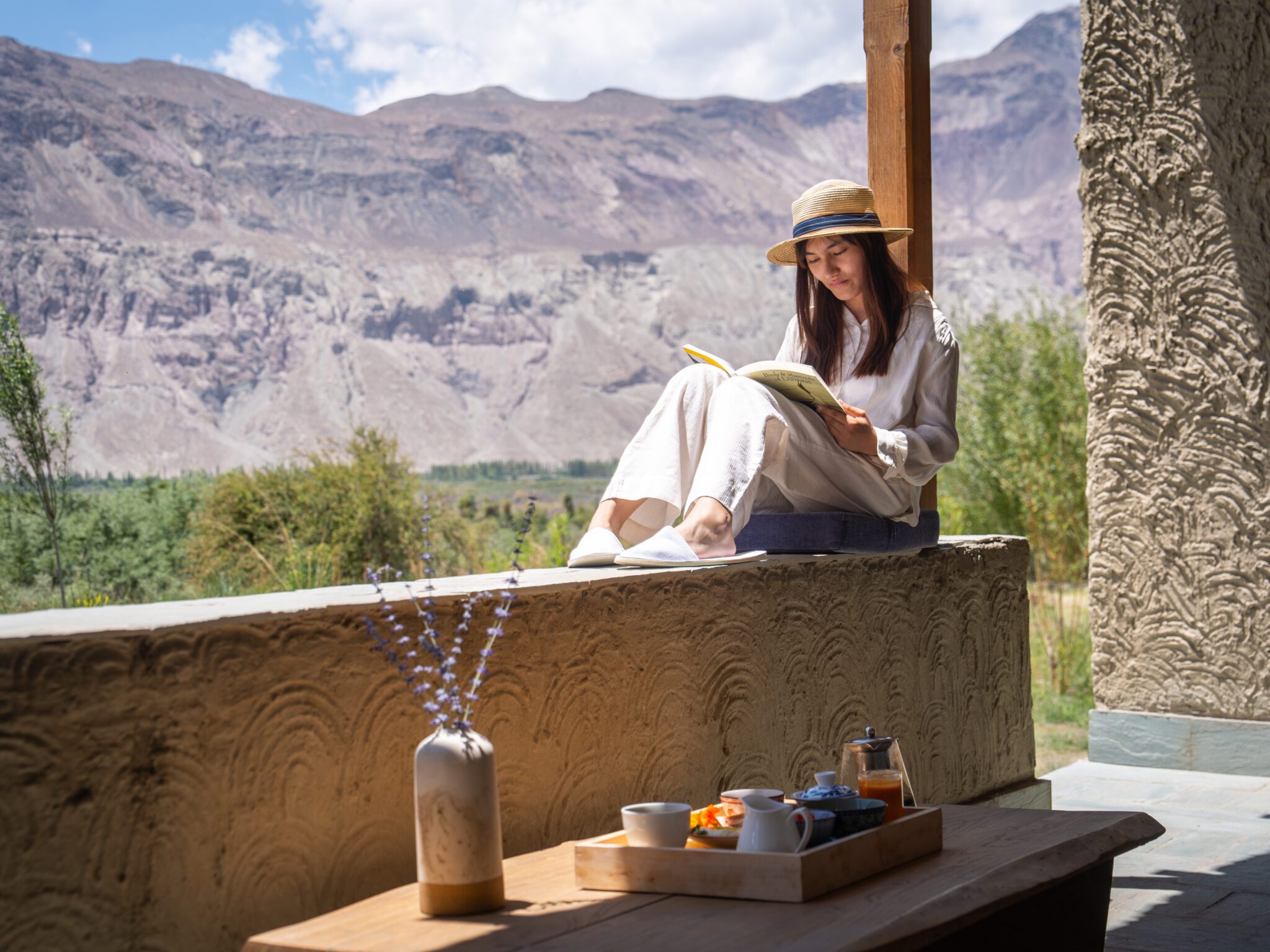
Best Experiences and Things to Do in Nubra Valley
Nubra Valley is not just a place to visit — it’s a place to experience. Beyond its striking landscapes and ancient monasteries lies a world of small, unforgettable moments. Whether you’re an adventure seeker, a cultural explorer, or simply someone looking to disconnect from the chaos of everyday life, Nubra offers a spectrum of experiences that stay with you long after the journey ends.
One of the most iconic experiences here is undoubtedly the camel safari on Hunder’s sand dunes. Riding a double-humped Bactrian camel through the golden desert, with snow-capped mountains rising in the distance, feels surreal. The silence of the desert is broken only by the soft pad of camel feet and the occasional rustle of wind in the dunes. It’s not just a photo opportunity — it’s a glimpse into the valley’s Silk Route past.
For those who crave panoramic views and spiritual stillness, climbing to the top of Diskit Monastery at sunrise or sunset is a must. As the light spills across the Shyok Valley, you’ll hear the deep, resonant chants of monks echo through the corridors. The towering Maitreya Buddha, gazing serenely across the mountains, adds a profound layer to the experience.
Adventurous souls can explore the hidden trails near Sumur, Ensa Monastery, and Yarma Gonbo. While Nubra isn’t yet a trekking hotspot like the Markha Valley, short day hikes take you into almond orchards, high cliffs, and ancient trails barely touched by tourism. Each path holds the promise of discovery — a wildflower, a view, or a silent shrine carved into the rocks.
For a slower pace, village walks in Turtuk or Panamik are deeply rewarding. These aren’t guided tours — they’re casual, spontaneous, and often punctuated by encounters with smiling locals, offers of apricots, or invitations for tea. Strolling through narrow alleys between homes built of stone and mud, you’ll witness daily life unfold with quiet dignity.
In the evenings, stargazing becomes its own form of meditation. The lack of light pollution means the sky in Nubra Valley is ablaze with stars — constellations you may have only seen in books stretch above you in dazzling clarity. From your guesthouse courtyard or a quiet ridge near Hunder, it’s the perfect way to end the day.
Don’t miss the chance to indulge in Ladakhi cuisine during your stay. Sip butter tea in a local kitchen, enjoy a bowl of steaming thukpa, or try skyu — a hearty pasta stew served with vegetables and yak butter. These meals, often cooked by homestay hosts or in eco-lodge kitchens, are stories told in flavor.
In Nubra Valley, experiences are not about ticking boxes. They’re about presence — being here, now, with all your senses open. It’s in the scent of incense at a mountaintop gompa, the warmth of tea shared between strangers, and the silence that says more than words. The best thing you can do in Nubra? Let it change you.

Best Time to Visit Nubra Valley
Timing is everything when it comes to visiting Nubra Valley. Hidden beyond the mighty Khardung La Pass, this high-altitude desert remains inaccessible for part of the year due to heavy snowfall. But when the valley does open its arms, it offers a different kind of magic with each passing season. Understanding when to go can transform your trip from simply memorable to truly unforgettable.
The most popular and practical time to visit Nubra Valley is between May and September. During these months, the roads from Leh to Nubra remain reliably open, the temperatures are comfortable, and the landscapes are at their most photogenic. May marks the end of winter and the beginning of bloom — wildflowers peek out across the valley floor, and the snow on the peaks still lingers, creating beautiful contrasts. By June and July, the apricot trees are full, the barley fields sway with life, and the whole region glows with vitality.
August and early September are harvest months in villages like Turtuk and Sumur, offering a chance to witness traditional Ladakhi and Balti agricultural life. You’ll see families gathering in orchards, drying apricots on rooftops, and preparing for the long winter ahead. This is also a great time to enjoy cultural festivals, often held in local monasteries with masked dances, prayers, and offerings.
October brings a sharp shift in temperature, with frost in the mornings and golden hues across the landscape. The skies remain clear, and the crowds begin to thin — a perfect window for travelers who prefer solitude. However, after mid-October, snow may start falling over Khardung La, cutting off road access without warning.
Winter (November to April) transforms Nubra Valley into an isolated wonderland. While travel during this season is challenging and limited to those with permits and proper gear, it offers absolute silence, frozen rivers, and raw beauty. Panamik’s hot springs feel especially magical during this time, with steam rising against a backdrop of snow-covered ridges.
It’s also important to consider altitude and acclimatization. Khardung La stands over 5,300 meters, and travelers coming straight from lower altitudes should spend at least one or two days acclimating in Leh before making the journey to Nubra. Avoid rushing — both your body and the landscape deserve the time.
Whether you seek the vibrant pulse of summer or the hushed breath of winter, Nubra Valley has something to offer year-round. The key is to match your interests and comfort with the season. Do you dream of camel rides on golden dunes under blue skies? Choose July. Want to sip butter tea beside a snow-covered window? Brave the chill of February. The best time to visit Nubra isn’t just about weather — it’s about what kind of traveler you are, and what kind of story you wish to take home.
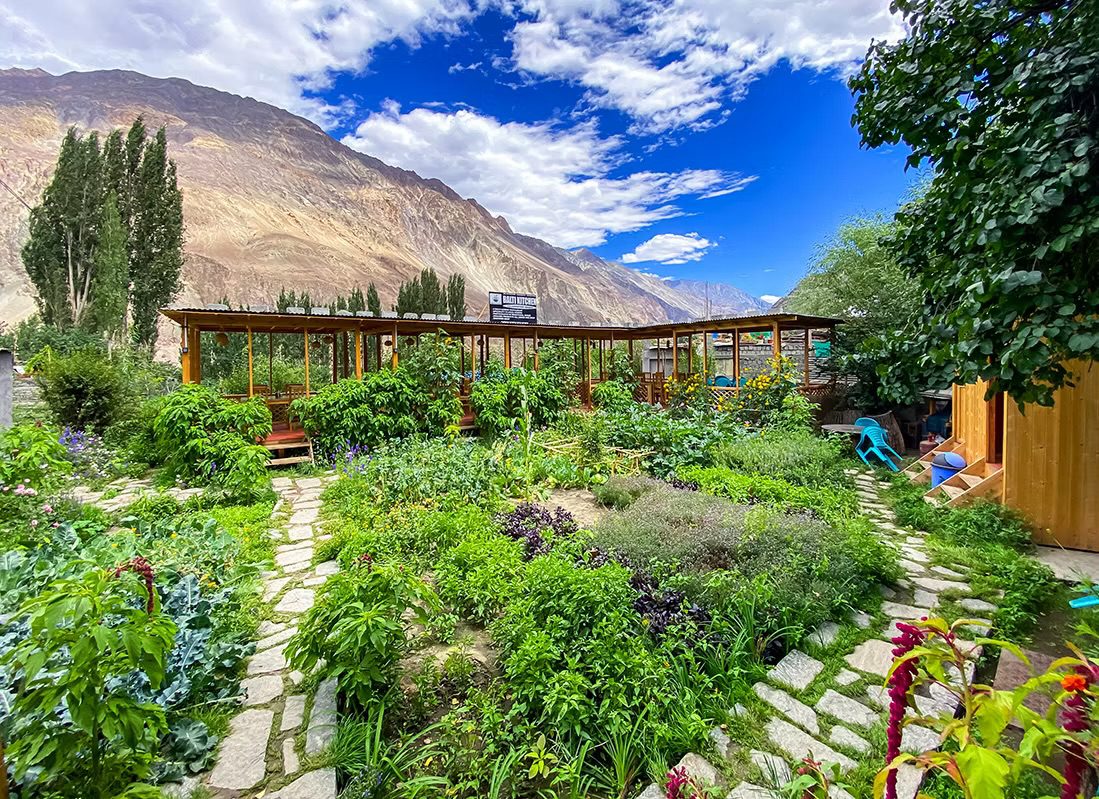
Travel Tips for Exploring Nubra Valley
Nubra Valley is unlike any other place in India — remote, majestic, and humbling. But with its altitude, climate, and limited infrastructure, traveling here requires more than just a sense of adventure. A little preparation goes a long way in making your journey smooth, safe, and memorable. Whether you’re heading to Diskit’s monasteries, the sands of Hunder, or the orchards of Turtuk, keep these essential travel tips in mind.
1. Acclimatize in Leh Before Heading to Nubra
Altitude sickness is real and can affect even seasoned travelers. Since the journey to Nubra Valley requires crossing Khardung La (over 5,300 meters), it’s important to spend at least two nights in Leh to allow your body to adjust. Drink plenty of water, eat light, and avoid alcohol before crossing high passes.
2. Obtain Your Inner Line Permit (ILP)
All travelers — Indian and foreign — need an Inner Line Permit to enter Nubra Valley. This can be easily arranged online or through travel agents in Leh. Keep multiple photocopies, as you’ll need to submit them at army checkpoints along the way.
3. Pack Smart — Weather Changes Quickly
Temperatures can vary drastically between day and night. During the day, you might be in a T-shirt, but by evening, the mercury can plummet. Pack layers: thermal wear, a good fleece, a windproof jacket, gloves, sunglasses, and a warm hat. Don’t forget sunscreen and lip balm — the sun at altitude is fierce.
4. Bring Cash — ATMs Are Rare
Once you leave Leh, don’t count on finding ATMs or card-friendly shops. Carry enough cash for food, accommodation, transport, and emergencies. Local businesses in Nubra Valley mostly operate on a cash basis.
5. Respect Local Customs and Culture
Nubra is home to both Buddhist and Balti Muslim communities. Be mindful of your attire, ask before taking photos of people, and remove your shoes before entering monasteries or homes. A small gesture of respect goes a long way.
6. Stay Connected — But Be Ready to Disconnect
Mobile networks are limited. BSNL and Jio offer the best coverage, but even these can be patchy. Consider informing someone about your travel plans before heading out. Embrace the chance to unplug — it’s one of Nubra’s hidden blessings.
7. Drive Carefully and Leave Early
If you’re renting a bike or car, start early in the day to avoid afternoon winds and to have enough daylight in case of delays. Roads can be unpredictable, especially after snowfall or landslides. Drive cautiously and honk before blind turns.
8. Support Local Economy
Choose homestays, buy locally-made apricot products, and tip guides and guesthouse staff fairly. Your travel choices have a direct impact on the livelihoods of the communities who call this fragile land home.
9. Carry Basic Medicines and Supplies
Pharmacies are limited outside Leh. Bring altitude medication (like Diamox), painkillers, digestive aids, and any prescription meds you may need. A basic first aid kit is always a good idea.
10. Travel with Patience and an Open Heart
Delays happen. Weather changes. Roads close. In Nubra Valley, time moves differently — and that’s part of its charm. Let go of rigid schedules and allow the journey to unfold at its own pace.
These tips aren’t just about safety — they’re about deeper travel. Nubra Valley isn’t just a place to see, it’s a place to feel. With respect, preparation, and an open spirit, your experience here will be nothing short of extraordinary.
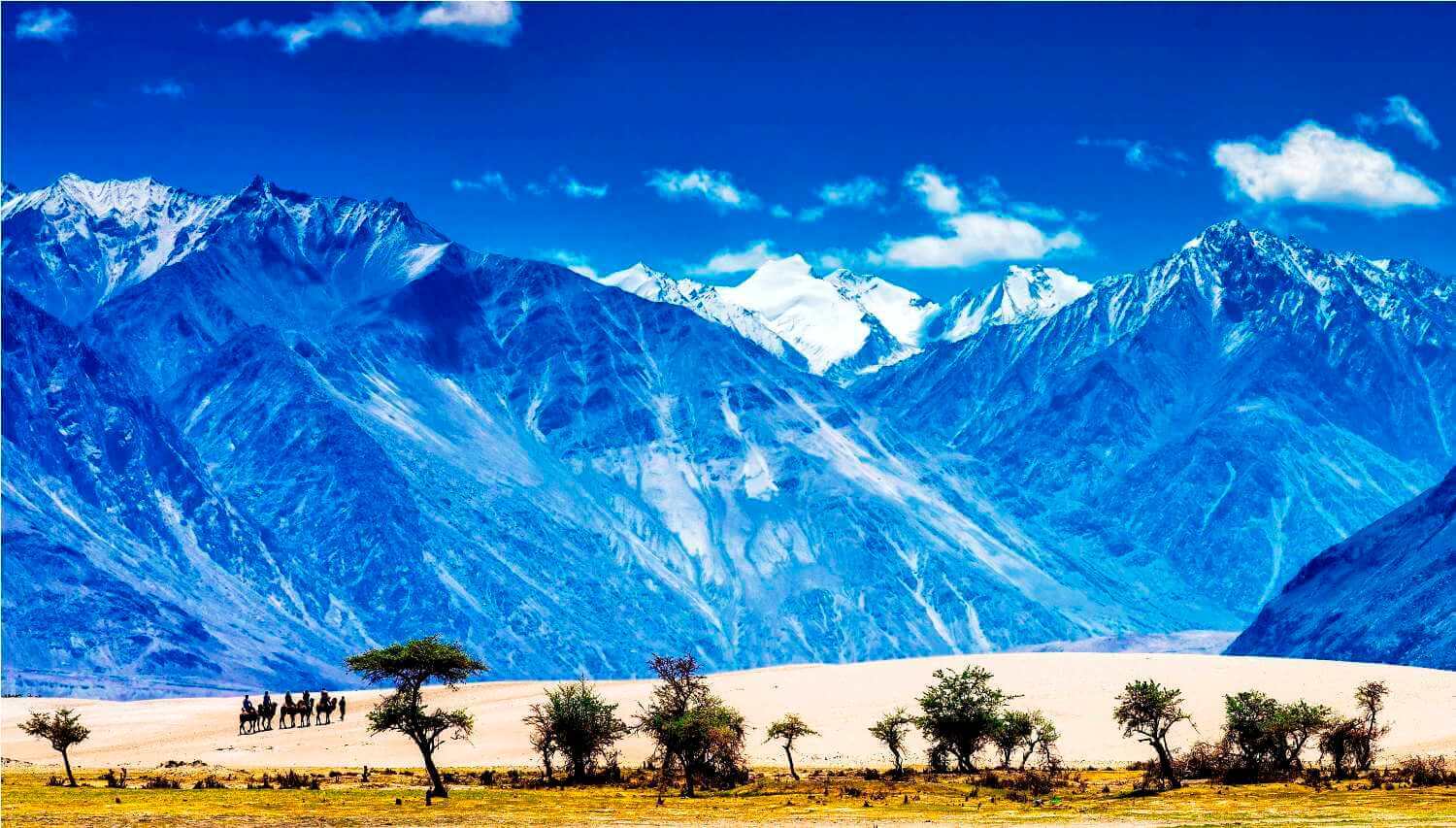
Frequently Asked Questions About Nubra Valley
Every traveler heading to Nubra Valley carries a sense of wonder — and a list of questions. From logistics and safety to culture and connectivity, this region is as complex as it is beautiful. Here’s a curated list of the most common queries, answered simply and clearly to help you prepare with confidence.
1. Do I need a permit to visit Nubra Valley?
Yes. Both Indian and foreign travelers need an Inner Line Permit (ILP) to enter Nubra Valley, as it lies close to the international border. Permits can be obtained online or at the District Commissioner’s office in Leh. Carry multiple photocopies for submission at checkpoints like South Pullu and North Pullu.
2. How many days should I spend in Nubra Valley?
Ideally, spend at least two to three nights. This allows you to explore Diskit, Hunder, Turtuk, Panamik, and maybe even take a detour to Sumur or Ensa Monastery. A three-day itinerary offers a well-paced, meaningful experience.
3. Is the road to Nubra Valley safe?
Yes, but it requires caution. The road over Khardung La Pass is steep and winding, with sharp drops and occasional landslides. During summer months (May–September), it’s usually well-maintained and manageable by car, SUV, or bike. Start early in the day and check road conditions in Leh before departure.
4. What kind of accommodations are available?
Nubra offers a variety of stays — from eco-resorts like The Kyagar and Lchang Nang to budget homestays in villages like Turtuk and Panamik. Accommodation is clean and comfortable, but modest. Luxury in Nubra comes in the form of warm hospitality, fresh meals, and a sky full of stars.
5. Is Nubra Valley suitable for solo travelers?
Absolutely. Nubra is welcoming, and solo travelers often find it to be a peaceful and safe destination. Locals are kind and curious, and the slower pace of life suits independent travelers well. Just make sure to inform your hosts or contacts about your route, especially if heading into remote villages.
6. Is mobile network coverage available?
Coverage is limited. BSNL and Jio offer the best chances of connectivity, especially in larger villages like Diskit and Hunder. But don’t rely on having internet access — consider it an opportunity to unplug and be fully present in nature.
7. What should I pack for Nubra Valley?
Bring layers: daytime temperatures can be warm, but nights are cold. Essentials include a warm jacket, sunscreen, sunglasses, refillable water bottle, power bank, basic medicines, and your ILP. If staying in remote areas, pack snacks and a flashlight.
8. Can I travel to Nubra in winter?
Technically yes, but it’s challenging. From November to April, Khardung La is prone to closures due to snow. Roads can be dangerous, and facilities in Nubra are limited during this time. Winter travel should only be attempted by experienced travelers with proper gear and arrangements.
9. Are camel rides ethical?
The Bactrian camels in Hunder are descendants of Silk Route traders and are cared for by local families. While camel rides are popular, always choose operators who treat the animals respectfully. Rides are typically short and regulated. Avoid overloading or riding camels showing signs of distress.
10. Can I combine Nubra with Pangong Lake?
Yes, via the Shyok route, which connects Nubra to Pangong Lake without returning to Leh. The drive is stunning but rugged, so only attempt it in a reliable vehicle and during the dry season (June to September). Always check conditions before setting out.
Still have questions? That’s part of the journey. In Nubra, some answers only come when you stop asking and start exploring.
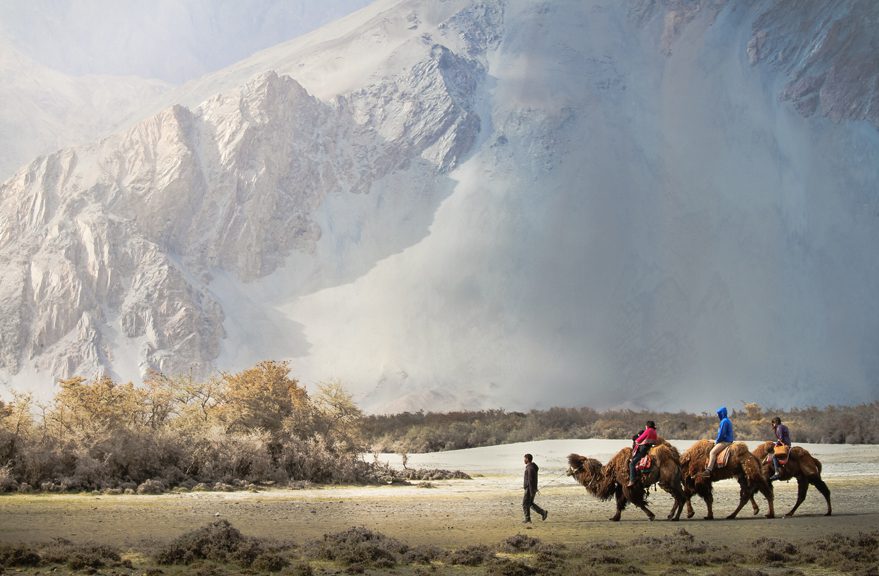
Sample 3-Day Nubra Valley Itinerary
While Nubra Valley deserves weeks of exploration, most travelers allot two to four days for their visit. To make the most of your time without rushing, here’s a well-balanced 3-day itinerary that captures the essence of the valley — from ancient monasteries and high-altitude deserts to remote villages and hot springs.
Day 1: Leh to Diskit via Khardung La — Welcome to the Cold Desert
Begin your journey early from Leh, heading north across the famous Khardung La Pass, which stands at over 5,300 meters. Pause at the top to take in the sweeping views and acclimatize gradually before descending into the green and golden embrace of Nubra. Arrive in Diskit, the valley’s largest village, and check into your eco-resort or homestay.
Spend your afternoon exploring Diskit Monastery. Climb to its prayer halls and admire the panoramic vistas from the base of the towering Maitreya Buddha statue. As evening falls, head to nearby Hunder sand dunes for a camel safari or a golden-hour photo walk across the desert. Enjoy a peaceful night under a starlit sky.
Day 2: Day Trip to Turtuk — India’s Northernmost Cultural Gem
After breakfast, take a scenic drive along the Shyok River toward Turtuk, the last accessible village before the Pakistan border. This Balti village is a world apart — with stone houses, apricot orchards, and a rich culture rooted in Central Asia.
Wander through its narrow lanes, visit the local museum, and savor a traditional Balti lunch with a local family. Engage with villagers to learn about their unique way of life. On your return, stop for views at high cliffs above the Shyok and maybe pause in a lesser-known village like Bogdang or Tyakshi if time permits. Return to Hunder or Diskit for the night.
Day 3: Panamik and Sumur — Hot Springs and Hidden Spirituality
Today, head east toward the charming villages of Sumur and Panamik. In Sumur, visit the peaceful Samstanling Monastery, where monks chant in a sunlit courtyard surrounded by barley fields. Then proceed to Panamik, known for its naturally heated sulphur hot springs. Take a soothing dip and relax before lunch.
If time allows, consider a short hike to Ensa Monastery, perched high above the valley, offering silence, faded murals, and a chance for quiet reflection. Begin your return drive to Leh in the afternoon, crossing Khardung La once more. Arrive back by early evening, with your heart full and your camera packed with memories.
This itinerary strikes a balance between cultural immersion, natural beauty, and relaxation. While customizable, it ensures you don’t just see Nubra Valley — you feel it. Add a buffer day if you can, for detours or simply lingering in the stillness that defines Ladakh’s most magical valley.
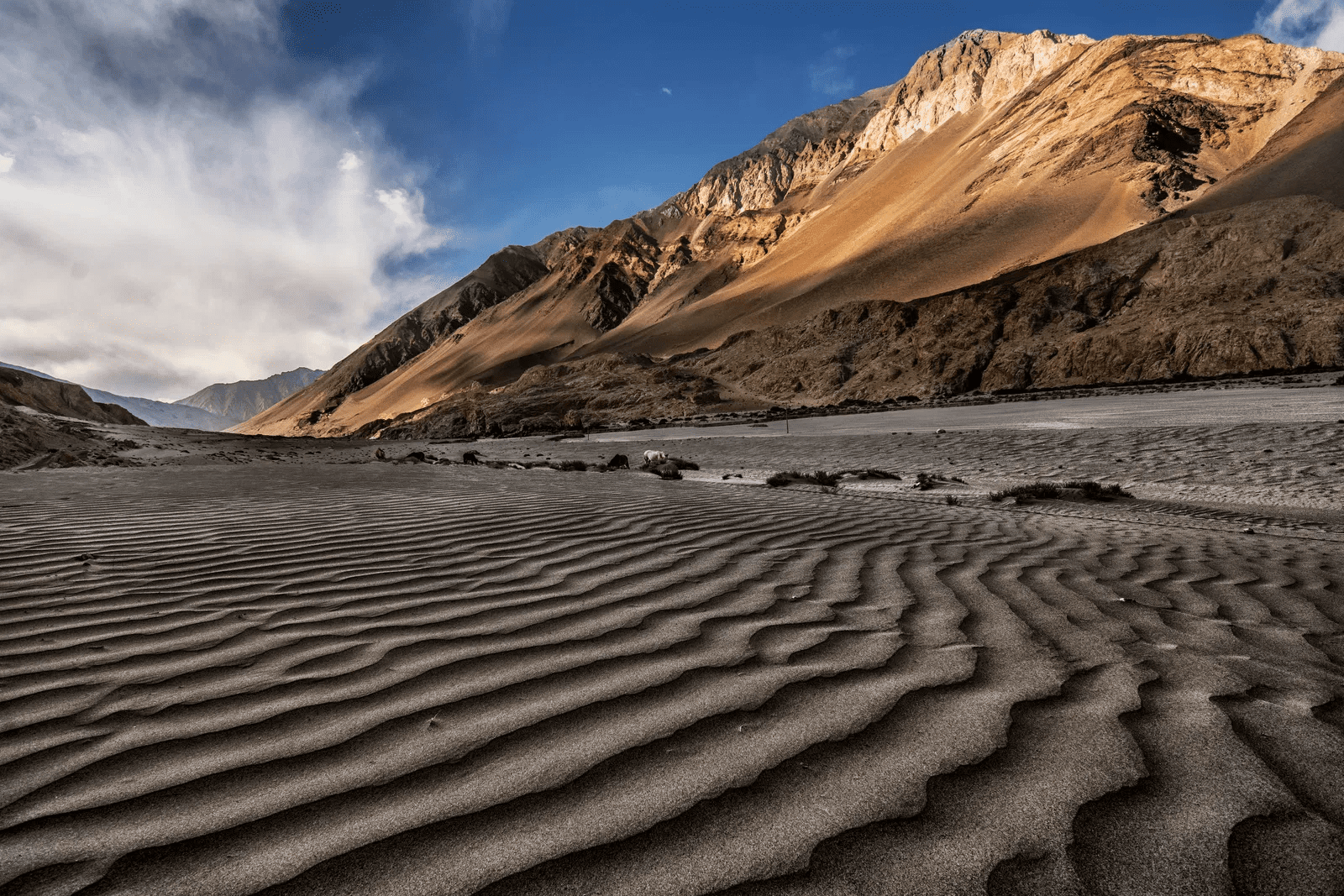
Final Thoughts: Why Nubra Valley Should Be on Your Ladakh Bucket List
There are places in the world that impress you with their grandeur — and then there are places like Nubra Valley that gently reshape you from within. Tucked beyond the world’s highest motorable road, Nubra isn’t just another stop on a Ladakh itinerary. It’s a destination that demands your attention, rewards your patience, and teaches you how to travel more mindfully.
Here, every moment invites you to pause. The way sunlight drapes across Hunder’s sand dunes. The silent watchfulness of the Maitreya Buddha in Diskit. The warmth of butter tea shared by a local family in Turtuk. The echo of chants in a mountain monastery. The laughter of children playing beside cold streams in a remote village. These are the fragments that stay long after the dust of the journey fades from your shoes.
Nubra is a valley of contrasts — where double-humped camels cross icy deserts, where Balti Muslim villages sit beside ancient Buddhist shrines, where modern eco-resorts coexist with humble homestays rooted in centuries of tradition. But more than contrasts, it’s a valley of co-existence. Of harmony. Of stillness.
If you’re searching for the soul of Ladakh, you may very well find it here — in the quiet resilience of its people, the untouched beauty of its landscapes, and the rituals that continue unchanged under the vast Himalayan sky. And in a world rushing ever faster, Nubra offers something we’ve all forgotten how to cherish: space, silence, and time.
So go — not just to take photos, but to learn. Not just to escape, but to connect. Let Nubra Valley slow you down, strip away the noise, and show you what it means to be small in the presence of something truly vast. Add it to your Ladakh bucket list not because it’s remote or dramatic — but because it’s real.
And when you leave, you may find that a part of Nubra doesn’t leave you at all.

